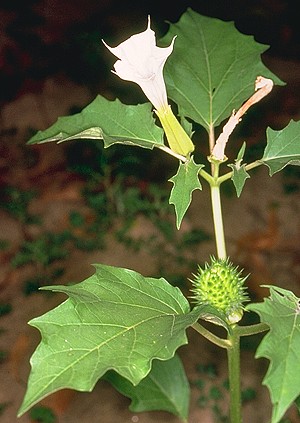
Synonymy
*Datura stramonium L., Sp. Pl. 1: 179 (1753)
T: "Habitat in America, nunc vulgaris per Europam"; Lectotype : Herb. Clifford: 55, Datura 1 (BM-000557989); fide D'Arcy in Woodson & Schery (ed.), Ann. Missouri Bot. Gard. 60 : 624 (1974).
D. tatula L., Sp. Pl. 2nd edn, 256 (1762); D. stramonium var. tatula (L.) Torrey, Fl. North & Middle U.S. 1: 232 (1824).
Lectotype : Herb. Linn. No. 243.2 (LINN); fide Hadkins & al. in Bot. J. Linn. Soc. 125 : 305, f. 15 (1998)
See the Linnaean Plant Name Typification Project pages for further details and Hadkins et al. (1997) for a discussion of the typification of both species.
E. S. Hadkins, R. Bye, W. A. Brandenburg, C. E. Jarvis (1997). Typification of Linnaean Datura names (Solanaceae). Bot. J. Linn. Soc. 125: 295-308.
Description
Stout annual herb, glabrous or sparsely pubescent with non-glandular hairs.
Mature leaves rhomboid to angularly ovate, the lamina up to 36 cm long, deeply lobed, the lobes few and usually coarsely toothed or sinuate.
Calyx 3–4 (occasionally to 5.5) cm long, 5–lobed, the lobes 6–8 mm long. Corolla 6–8 (occasionally to 10) cm long, white or pale lavender; limb 5–lobed, the lobes ending in a slender point c. 10 mm long. Stamens not exserted; anthers 3–6 mm long. Style 4–6 mm long; stigma below, level with or above anthers.
Capsule ovoid, to 4.5 cm long, erect, spiny; spines 100–200, slender, conical, sharp, variable in length, the longest less than half length of capsule; persistent base of calyx to 10 mm long. Seeds 2.5–4.5 mm long, black or grey.
Distribution and ecology
Origin uncertain, but widely naturalised in temperate and warm-temperate regions of the world. Widespread in Australia, occurring in eastern Qld, N.S.W., A.C.T., Vic., eastern Tas., S.A. and south-western W.A. Robert Brown Collected a species of Datura in the Sydney region in 1802-4 (see Brown's list of introduced plants for the Sydney region reproduced in Journal of Botany 44: 234-5); it seems most likely to be this one, but the specimen at Kew needs to be checked.
Weed of waste ground, disturbed areas in agricultural districts, and along creek beds in semi-arid native pastures.
Common name
Jimsonweed
Notes
Seeds sometimes toxic, contaminating grain and causing death of poultry and pigs.
The names D. tatula L. and D. stramonium var. tatula (L.) Torrey were used for lavender-flowered forms in earlier Australian literature.
Robert Brown recorded a Datura species, probably this one, as already growing "on rubbish-heaps between Sydney and Parramatta" between 1802-4 (J.Britten, J. Bot. (1906) 44: 234).
Selected specimens
S.A.: Wanilla, C.R. Alcock 2675 (AD, ADW). Qld: Thallen, S.L. Everist 841 (BRI). N.S.W.: near Merimbula, L. Haegi 1723 (NSW). Vic.: East Gippsland, A.C. Beauglehole 37044 (MEL). Tas.: Hobart, 16 Feb. 1966, D.I. Morris (HO).
Derivation of epithet
From the Latin stramonium, meaning spiked fruit.
Images and information on web
The Datura and Brugmansia Society has images of various life stages of this species on its site: see www.abads.net/datura/stramonium/
Images of D. stramonium flowers and fruits can be seen at http://florabase.calm.wa.gov.au/browse/photo/6964
There are numerous images of this species in the Image Gallery for Datura of the United State Department of Agriculture (USDA) and on the CalPhotos website.
Further information can be found on the Weeds in Australia site.
A fact sheet on the effects of D. stramonium on animals can be downloaded from the Australian Weeds and Livestock pages dealing with the effects of plants on various farm animals.
Further information about the toxic properties of this plant can be found with a search in the FDA Poisonous Plant Database
D. stramonium as a weed in the Pacific is treated on the Pacific Island Ecosystems at Risk (PIER) site.
A comprehensive fact sheet on D. stramonium in
The detailed image of D. stramonium from Koehler's Medicinal-Plants (1887) can be accessed under “Thornapple” at http://pharm1.pharmazie.uni-greifswald.de/allgemei/koehler/koeh-eng.htm
Plant status (if any)
General information about Datura species as declared plants in
All species of Datura are declared in Western Australia, Tasmania and Northern Territory while D. ferox, D. inoxia and D. stramonium are included in Victorian legislation.
Information on the occurrence and declaration of Datura in
A fact sheet for this species can be downloaded from the SA eFlora site.




